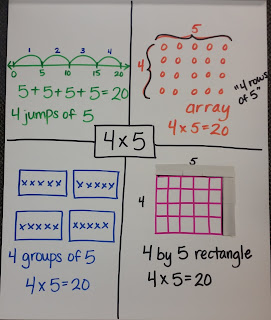"My 20+20 is different than her 20+20"
If you teach math and are not doing number talks in your classroom, you and your kiddos are missing out! If you're looking for high engagement, mathematical discourse, risk taking and deep student thinking, number talks are the ticket. Simply put,
I have been so lucky this year to support teachers in bringing number talks into their classroom. I've gotten to train teachers, demonstrate number talks as a guest teacher, and watch teachers hone their own practice in their classrooms. A few weeks ago, I had the pleasure of working with a 4th grade class on a number string, and together, we learned so much! A number string is a purposefully chosen set of expressions that build on each other. Our number string was:
Setting a goal for a number talk is an important part of the process. For this number string, I wanted to focus on properties of multiplication (associative and distributive properties) and relational thinking (how does knowing 4x5 help us solve 4x10? 4x50?) Finally, I was hoping to give students a mental ladder to a more complicated problem: 4x49. I also hoped to bring out various models to represent student thinking (number lines, arrays, area models, etc;)
The first problem posed to students was 4x5. In a 4th grade classroom, we would *hope* that most students would know this fact from memory. Knowing that many students would know this answer "by heart" (something I capture during number talks recording by drawing a heart next to an answer), I encouraged students to think of a way that they could "prove" that 4x5=20. This is what students came up with:
It was awesome to see the variety of strategies that students had in their "tool belt" for thinking about multiplication! From an understanding of equal groups as repeated addition (2.OA.4)) to "groups of" (3.OA.1), to arrays with rows and columns (2.OA.4, 3.OA.3) to multiplication as area (3.OA.7), this class demonstrated a deep conceptual understanding of 4x5.
You may be thinking, why push students to come up with "another way" for a problem they have committed to memory? The power in doing this for this number talk was knowing where we were going with this problem. I wanted students to be able to call on models that they were able to use for their thinking with smaller problems when we got to more complicated problems. If I, as a student, understand that 4x5 can be represented as a rectangle with dimensions of 4 and 5 and the product is the area of that rectangle, then I can use the same model when I get to a problem like 4x49.
The next problem in the number string was 4x10. This was another answer that I hoped students knew "by heart", but I wanted to push them to apply some multiplication properties to justify it. Alondra shared her thinking first.
At this point in the number talk, our time was up, but the rich conversation about 4x10 was a perfect primer for the next problems in the number string and a deeper investigation of distributive property and area model. Alondra's and Andy's ways helped shape their classmates' thinking, and mine as well!

"Number talks are 5-15 minutes classroom conversations around purposefully crafted computation problems." ~Sherry ParrishThe name "number talks" is fitting because it means engaging students in, you guessed it, talking about numbers. The goal of number talks is computational fluency, and this is furthered by students using mental math to become more flexible and efficient in their problem solving.
I have been so lucky this year to support teachers in bringing number talks into their classroom. I've gotten to train teachers, demonstrate number talks as a guest teacher, and watch teachers hone their own practice in their classrooms. A few weeks ago, I had the pleasure of working with a 4th grade class on a number string, and together, we learned so much! A number string is a purposefully chosen set of expressions that build on each other. Our number string was:
4x5
4x10
4x50
4x49
4x49
The first problem posed to students was 4x5. In a 4th grade classroom, we would *hope* that most students would know this fact from memory. Knowing that many students would know this answer "by heart" (something I capture during number talks recording by drawing a heart next to an answer), I encouraged students to think of a way that they could "prove" that 4x5=20. This is what students came up with:
It was awesome to see the variety of strategies that students had in their "tool belt" for thinking about multiplication! From an understanding of equal groups as repeated addition (2.OA.4)) to "groups of" (3.OA.1), to arrays with rows and columns (2.OA.4, 3.OA.3) to multiplication as area (3.OA.7), this class demonstrated a deep conceptual understanding of 4x5.
You may be thinking, why push students to come up with "another way" for a problem they have committed to memory? The power in doing this for this number talk was knowing where we were going with this problem. I wanted students to be able to call on models that they were able to use for their thinking with smaller problems when we got to more complicated problems. If I, as a student, understand that 4x5 can be represented as a rectangle with dimensions of 4 and 5 and the product is the area of that rectangle, then I can use the same model when I get to a problem like 4x49.
The next problem in the number string was 4x10. This was another answer that I hoped students knew "by heart", but I wanted to push them to apply some multiplication properties to justify it. Alondra shared her thinking first.
Alondra: "I used the first problem to help me. I knew that 4x5 was 20, and 4x10 is 4x5 two times."
Me: "How did you know that 4x10 was 4x5 two times?"
Alondra: "Well, I can decompose 10 into 5 and 5. Then I can multiply 4 by both of those 5's"
Me: "So, I can break apart the 10 into 5 and 5 and then multiply 4 by both of those 5's. 4x5 plus another 4x5 is the same as 4x10?"
Alondra: "Yes, and 20 plus 20 is 40, so 4x10=40."I captured her thinking like this:
Me: "And you know what? Alondra just applied one of the properties of multiplication. Does anyone know what we call it when we multiply a factor by the sum of the other factor?"
Many students: (Thinking time. Partner share.) "Distributive property!"Andy shared his thinking next:
Andy: "I did it sort of like Alondra, but I broke apart the 4 instead of the 10. I thought of 2x10 and 2x10."
Me: "So, 4 can be decomposed into 2 and 2, and then you multiplied each of those 2's with the 10."
Andy: "Yeah, and it's still 20+20 like Alondra's, but it's a different 20 plus 20.I captured Andy's thinking like this:
I was interested in pursuing Andy's thought that his 20+20 was "different" than Alondra's 20+20. Having learned from our first problem that students were familiar with the area model for multiplication, I drew two area models on the poster:
Me: "So, both Alondra and Andy have a strategy for solving 4x10 by breaking apart one of the factors and using the distributive property. Here are area models for both of them. I'm wondering if we can show Alondra's and Andy's ways in our area model."Students were given time to think and partner share. I listened in on a few partner conversations and decided I needed to ask one more question to support students in their thinking.
Me: "Where in Alondra's area model do you see the two 4x5s?"
Student: "You could draw a line like this (drawing a vertical line in the air) and then the side that's 10 would be broken up into 5 and 5."I drew the line indicated by the student, and together we confirmed that now each part of the rectangle showed 4x5.
Me: "So, now this area model shows Alondra's way. What about our area model for Andy's way. How could we show his way on this area model?"Students thought about it. Several students looked excited and started to draw horizontal lines in the air. After an opportunity to chat with a partner, students were on board with the idea that we could draw a horizontal line in our area model to capture Andy's thinking about decomposing the 4 into 2 and 2.
Me: "Talk to the person next to you about how Alondra's 20+20 is different than Andy's 20+20."Students were excited to justify their thinking and were successfully able to refer to the model as support for their justification. With such a simple problem, students were able to affirm their correct use of distributive property and the area model, an important step in being able to generalize these strategies to larger numbers.
At this point in the number talk, our time was up, but the rich conversation about 4x10 was a perfect primer for the next problems in the number string and a deeper investigation of distributive property and area model. Alondra's and Andy's ways helped shape their classmates' thinking, and mine as well!









Comments
Post a Comment